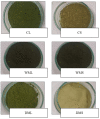Effects of Wet and Dry Micronization on the GC-MS Identification of the Phenolic Compounds and Antioxidant Properties of Freeze-Dried Spinach Leaves and Stems
- PMID: 36500267
- PMCID: PMC9740432
- DOI: 10.3390/molecules27238174
Effects of Wet and Dry Micronization on the GC-MS Identification of the Phenolic Compounds and Antioxidant Properties of Freeze-Dried Spinach Leaves and Stems
Abstract
Micronization is an emerging technology used in food production, in which the size of particles is reduced to microns in the processing of plant raw materials and by-products, thus making it an interesting research topic. Spinach stems are by-products of spinach leaf processing, but there is little information regarding their processing and possible reuse. In this study, wet and dry ball mill micronization, in combination with freeze drying, was used to process spinach stems and leaves to obtain functional powders. The color and particle size of the micronized spinach leaf and stem powders were evaluated. The antioxidant activity (AA) of the powders and phenolic compounds present in them were determined using GC-MS analysis. The results obtained showed that the dry micronization of leaves and stems resulted in smoother and brighter powders than wet micronization. Significantly smaller particle sizes were achieved using the dry micronization of the leaves and stems (Dv50 = 19.5 and 10.1 µm, respectively) rather than wet micronization (Dv50 = 84.6 and 112.5 µm, respectively). More phenolic compounds, such as o-coumaric acid and gallic acid, were extracted from the dry-micronized powders. The dry micronization of the stems significantly increased the total phenolic content, and the AA of these powders was also increased. These findings demonstrate that spinach leaves and stems subjected to dry micronization can be valuable functional components of food.
Keywords: antioxidant activity; freeze drying; grinding; micronization; particle size; phenolic compounds; spinach by-product; spinach leaves; spinach stems.
Conflict of interest statement
The authors declare no conflict of interest.
Figures



References
-
- Dhiman A., Prabhakar P.K. Micronization in food processing: A comprehensive review of mechanistic approach, physicochemical, functional properties and self-stability of micronized food materials. J. Food Eng. 2021;292:110248. doi: 10.1016/j.jfoodeng.2020.110248. - DOI
MeSH terms
Substances
LinkOut - more resources
Full Text Sources
Medical
Miscellaneous

